We at the Triplehorn Insect Collection frequently receive inquiries from students and even professionals seeking opportunities to learn about insects and insect collections. Some people are looking for training in a specific area, others have a more general interest. We also receive many inquiries regarding volunteering and research opportunities in the collection. We try to accommodate as many requests as our staff and resources allow.
In recent years we have had many undergraduate student interns in the collection. Most of them were Entomology majors at Ohio State, some were majoring in Biology, Zoology, and event in Art. We also had student interns from other colleges and universities. Some of these students spent a summer with us, others took internships during the semester for school credit. Some stayed for several semesters, others only a couple of weeks.
Because of the growing interest, we decided that it was time to make the internship offers a bit more structured. A few weeks ago we announced two internship opportunities for the fall semester, one for insect imaging and one for insect curation. As the email inquiries started arriving, it quickly became clear that there was interest (we received 25 inquiries in 10 days), but there was also some confusion on what an internship is versus an undergrad research experience, an undergrad job, or volunteering.
So what is an internship? How does that differ from volunteering? Is internship the same as research experience? What’s the deal with internship for school credit?
Here is our take:
Internship – Our understanding of internship is that it is a ‘mentored, practical learning experience in a professional environment’. Mentored, because it’s important that the experience be structured and directed. An intern, in our opinion, should not be given a task and left to fend for themselves. Our interns come in during regular hours only and are always monitored by a trained staff or experience student worker. Practical emphasizes that the intern will take what they have learned, both previously and as part of the internship experience, and put it to good use. The word experience has popped up several times: this is meant to emphasize (as does practical) that we want to do more than just talk about the work we do, we want the interns to actually do it. Finally, we mean professional environment not in terms of funds, but in terms of being serious and implementing whatever the best practices are.

Cherokee Read-Hill working on pollinator identification

Cherokee Read-Hill brought her own collection to study and ID

Alex DeMilto, MSc in Entomology, spend 6 months in the collectin to learn more about insect curation

Alex DeMilto working on curation of beetles
There is something that is deliberately missing in that definition, though, and that is any mention of financial compensation. Some places offer paid internships. We do not. First, we simply cannot afford it. Second, what we provide is an educational opportunity in a university environment and we take the responsibility to make it a structured, mentored experience.
Beyond the practical learning experience, students can get school credit for their efforts by enrolling in formal internship course (in our department this is EEOB 3191, 1-3 credit hours; other departments offer some form of internship courses as well). And whether one enrolls for credit or not, at the end of the day the intern – we hope – has made the kind of personal connection with their mentor that makes for a substantive and useful letter of recommendation later on when they apply for a real job, grad school, med school, etc.
Note that research internships involve actively working in a research project under supervision of a faculty or research scientist. That is not the kind of internships we are currently offering. The broad goal of our insect curation internship is to familiarize students with the work involved in maintaining and enhancing a research quality insect collection. Specific objectives involve learning the basics of insect specimen preparation (sort, dry, mount, and label insect specimens). In addition, student interns are offered opportunities to learn other techniques and protocols, depending on their progress, their (and our) time availability, and their interest.
Volunteering – The core of volunteering is that the person donates their time and effort in support of an organization, projects, etc. As such, it can overlap a lot with our concept of intern. But it differs, basically, in that we’re not necessarily promising a well-rounded, holistic and mentored experience. Volunteers come to us willing to help in whatever capacity because they think our work is valuable in some way. We try to match the tasks with the experience that volunteers already have: one person might be particularly good with organizational skills, another with the fine motor skills needed to mount and label specimens. And while interns are typically young persons looking to gain skills and experience, our volunteers run the gamut in ages, from teenagers to retirees. Right now we have two amazing volunteers: Lauralee Thompson, who has just completed one year of volunteering with us on Sept 8, and Jan Nishimura.

Volunteer Jan Nishimura working with fossil collection

Volunteer Lauralee Thompson transferring specimens to safe storage boxes

Zach Griebenow, Entomology major at OSU, volunteering at the Insect Summer Camp 2016

Metro School student Nirupama volunteering during the summer
Student Job – When we advertise a ‘undergraduate curatorial assistant’ job, it means 1) we can only hire undergraduate students (that’s what our money is earmarked for), 2) we have a particular set of goals to accomplish in a particular time and we offer training on the specific tasks related to the job, and 3) it is just the nature of an insect collection, in particular, the large number of specimens, that the tasks are likely to be repetitive and tedious.

Data transcription and locality georeferencing are some of the tasks performed by student workers

Student workers help with miscellaneous curatorial tasks such as moving specimens and drawers

Student workers add unique identifier to specimens prior to databasing
In the end, though, students who are hired, say, to do specimen data entry, end up learning a lot about the various aspects of the curation as they will have the need to perform some of them, they also learn about geography, computers, and, no surprise, about insects. For young persons, jobs like the ones we offer are also great opportunities to learn good work habits and to foster and demonstrate attributes like reliability, honesty, diligence, perseverance, ability to learn and to work with others in a collaborative way. Then, this too can translate into the kind of reference letter that really makes a difference to a potential new employer.
We currently have two specimen digitization projects funded by the National Science Foundation, one for beetles, and another, that just started, for butterflies and moths. Neither of these projects would be feasible without the work of our undergrad curatorial assistants.
One thing is common between interns, volunteers, and student workers: they are all learning and they all need care and attention from the collection staff. It is important for us, staff, supervisors, faculty, to engage with them and to nurture their interest in the work we do. That not only helps to keep them motivated, but it also fosters good interactions between everyone in the collection, and provides them with a positive experience that they will hopefully remember and cherish for the rest of their lives.
Current Digitization Projects:

Ground beetles (Carabidae) in the collection

Parshall Butterfly collection
Digitization PEN: Integration of data from the Triplehorn Insect Collection with the Southwestern Collections of Arthropods Network. Award #1503659. Start Date: July 1, 2015, Estimated End: June 30, 2018. Investigator(s): Norman Johnson & Luciana Musetti.
Digitization TCN: Collaborative Research: Lepidoptera of North America Network: Documenting Diversity in the Largest Clade of Herbivores (LepNet). Award #1602081. Start Date: July 1, 2016, Estimated End: June 30, 2020. Subcontract from the University of Northern Arizona to Norman Johnson & Luciana Musetti.
If you would like to know more about our internship program, about the digitization projects underway in the collection, or about possible collection-based undergraduate research experience, please contact us at osuc-curator@osu.edu.
About the Authors: Luciana Musetti is an Entomologist and Curator of the Triplehorn Insect Collection. Norman Johnson is a Professor in the Department of EEOB and Director of the Triplehorn Insect Collection.





















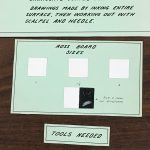

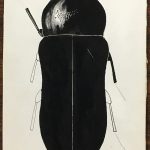























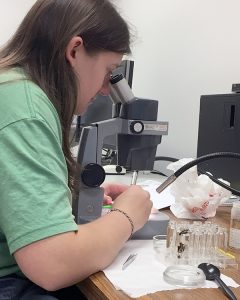

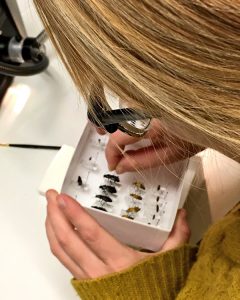

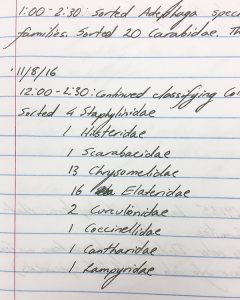

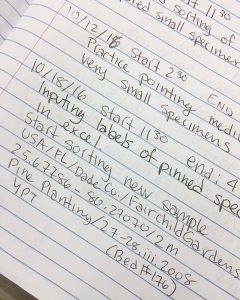
 Last semester we of the Triplehorn Insect Collection offered our first
Last semester we of the Triplehorn Insect Collection offered our first 





































